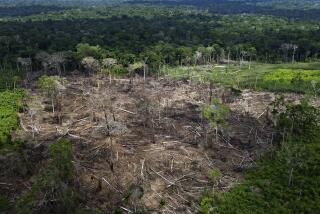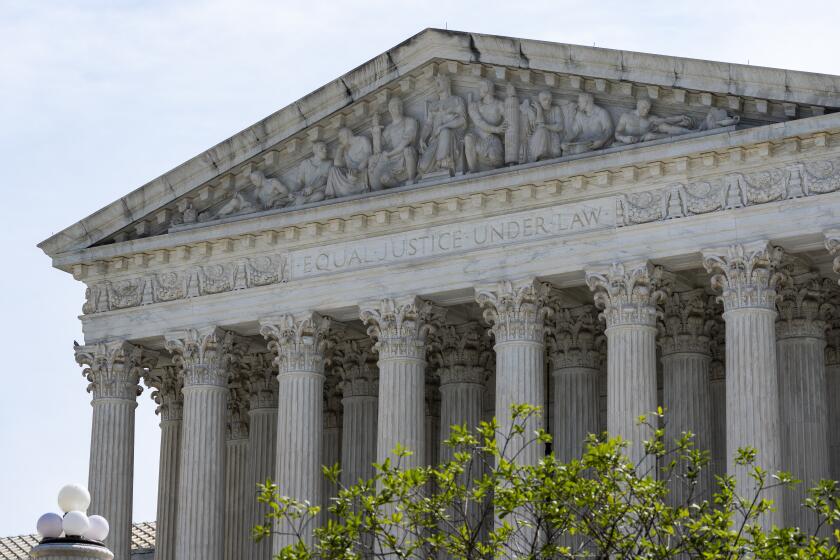North Korea Waking Up to Dangers of Deforestation
- Share via
SEOUL, South Korea — Lunching recently at one of his resorts, North Korean leader Kim Jong Il mused that the capital of rival South Korea was a handsome city with a grave flaw: bad air.
Certainly, the mountains that border Seoul fade from sight on a smoggy day and the roads are often choked with cars, unlike the communist North’s Pyongyang, a capital of parks and boulevards with a sixth of the population.
Pyongyang, with 2 million residents, has cleaner air largely because there isn’t enough money or gasoline for more vehicles, belying the dire state of North Korea’s environment.
The key problem is deforestation. So many hills have been stripped of trees that Kim plans to plant millions more, a sign that customarily recalcitrant North Korea may be waking up to outside warnings.
Business and political contacts aside, offers to help fix the North’s environment are a way for the world to engage the aloof country, which frequently excoriates South Korea and the United States.
The approach has met with mixed success. Pyongyang has rebuffed Seoul’s requests to cooperate on protection of coastlines and border flood control despite deadly floods this summer.
An armistice, not a permanent peace treaty, was signed at the end of the 1950-1953 Korean War, and a heavily fortified border divides the two Koreas.
Nonetheless, an office of the United Nations Development Program in Pyongyang is working with North Korea on reforestation. This year, South Korean activists sent seeds, fertilizer and greenhouse equipment for tree-growing after meeting North Korean officials.
“They showed a feeling of urgency,” said Dr. Yoo Jae Hyun of the Semin Foundation, a nongovernmental organization based in Seoul.
Recently the North’s foreign news outlet, KCNA, declared that the country had embarked on “nature-remaking projects.” “A brisk drive is now underway in Pyongyang to plant thousands of willows and poplars and hundreds of thousands of flower trees in parks and recreation grounds,” it said.
Coal-burning is the main source of energy in North Korea, and air pollution is spreading. But most forests, save for those in tourist areas, have been chopped down by people desperate for cooking or heating fuel, and the state has trucked timber for sale in China.
The clearing of the woods contributed to the crisis that began in 1995 and lingers today.
Heavy downpours swept away topsoil that was no longer held in place by tree roots, and the water runoff swelled floods that devastated crops. In the dry season, loose earth quickly shed moisture, leading to water shortages.
North Korea released figures showing that 220,000 people died of famine between 1995 and 1998. U.S. and South Korean estimates put the number at 2 million to 3 million.
Economic mismanagement and poor crop-terracing contributed to the disaster. North Korea, as a result, relies on outside food aid.
Kim didn’t dwell on North Korea’s woes in an Oct. 1 chat with Chung Ju-yung, the visiting head of the Hyundai group, South Korea’s biggest conglomerate. But he gave a hint of environmental consciousness.
“I’ve seen Seoul in movies and found it to be a world-class city which looks better than Tokyo,” Chung quoted Kim as saying. “We Koreans can be proud of it, but it has serious pollution problems.”
South Korea now has strict environmental laws, but it damaged coastlines, waterways and woods in a decades-long race toward industrialization. Today Seoul officials often issue ozone warnings.
Chung wants to build an industrial park in the North and already operates boat tours for South Korean tourists to Diamond Mountain, a scenic site there.
The tour project has drawn criticism from environmentalists who say Hyundai’s plans to build hotels, ski slopes and golf courses by 2030 will disrupt the ecosystem.
However, impoverished North Korea, which spends enthusiastically on its military, may put cash ahead of conservation.
More to Read
Sign up for Essential California
The most important California stories and recommendations in your inbox every morning.
You may occasionally receive promotional content from the Los Angeles Times.













